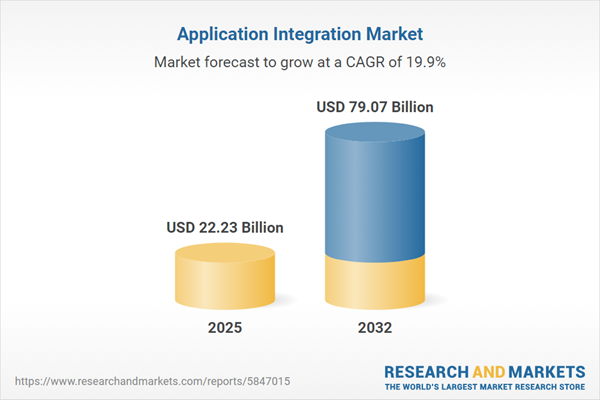Speak directly to the analyst to clarify any post sales queries you may have.
Enterprises are strategically prioritizing application integration to streamline operations, unify digital infrastructures, and support agile business growth. This report equips senior decision-makers with an in-depth view of the evolving application integration market, addressing emerging technology trends and proven strategies for optimizing digital transformation initiatives.
Market Snapshot: Application Integration Market Size and Growth
The application integration market is experiencing strong expansion as organizations seek unified digital environments and seamless connectivity across applications. As of 2024, the sector is valued at USD 18.50 billion, with projections indicating a robust compound annual growth rate of 19.90%. By 2025, market value is expected to reach USD 22.23 billion, with future projections estimating a total market size of USD 79.07 billion by 2032. This growth is driven by innovation in API-centric architectures, advanced integration platforms, and an increasing need for synchronizing cloud-based and traditional systems. Companies are investing in frameworks that enable efficient migration from legacy environments, making large-scale digital transformation more accessible and reducing operational silos.
Scope & Segmentation: Application Integration Market
- Solutions and Services: Enables robust interoperability across business applications, ensuring secure data flows and automated workflow execution between multiple platforms.
- Middleware: Incorporates enterprise service buses and API management, designed to enhance operational agility, lower vendor dependencies, and fortify overall business continuity.
- Advisory and Support: Provides expert guidance and technical support to help businesses implement, expand, and secure integration infrastructure aligned with specific organizational needs.
- Deployment Mode: Offers flexibility with on-premises, public or private cloud, and hybrid deployment models, supporting compliance, data privacy, and business resilience.
- Organization Size: Scalable integration platforms serve both small and large enterprises, allowing for incremental scaling or enterprise-wide deployment methods to match diverse requirements.
- End User Industry: Addresses varied needs across sectors like financial services, healthcare, logistics, energy, government, manufacturing, telecom, retail, and consumer goods that depend on efficient, compliant operations and real-time data visibility.
- Vertical Adaptability: Configures solutions to address specific regulatory obligations, operational processes, and governance protocols unique to each industry vertical.
- Regions: Adoption patterns vary by region, influenced by digital infrastructure maturity and regulatory frameworks across the Americas, Europe, Middle East, Africa, and Asia-Pacific.
- Country-Focus: Priorities differ between markets such as the United States, China, Germany, India, Japan, and Australia, shaped by local technology investments and regulatory environments.
Key Takeaways: Strategic Insights for Senior Executives
- Centralized integration models improve real-time operational visibility, allowing leaders to rapidly respond to dynamic market conditions and optimize internal coordination.
- Adoption of cloud-native and hybrid integration approaches enables international scalability while addressing distinct compliance and privacy challenges in different regions.
- Integrating automation and artificial intelligence into workflows accelerates decision-making, enhances governance, and improves process efficiency across business functions.
- Industries governed by complex regulations, such as finance and healthcare, benefit from solutions that strengthen data controls and simplify compliance management.
- Partnering with specialized technology providers supports adaptability and positions organizations to address changes in global digital and regulatory frameworks.
Tariff Impact on Integration Strategies
Recent U.S. technology tariffs are influencing how enterprises evaluate sourcing and vendor relationships. Senior executives are placing greater emphasis on working with integration specialists to ensure continual system performance and data security. Focus is shifting toward building more resilient supply chains and selecting solutions that mitigate regulatory and geopolitical risks for ongoing integration stability.
Methodology & Data Sources
This analysis draws from extensive reviews of industry whitepapers, regulatory documentation, and in-depth interviews with sector stakeholders. Quantitative data is complemented by independent expert surveys to deliver reliable insights on market dynamics and adoption of integration technologies.
Why This Application Integration Report Matters
- Enables executives to benchmark integration maturity, aligning investment strategies with core transformation objectives and competitive positioning.
- Delivers practical insights on meeting regulatory and geographic demands, equipping businesses to build scalable, secure digital integration frameworks.
- Identifies leading technology vendors with proven capabilities in supporting evolving enterprise integration needs.
Conclusion
Investing in integrated application strategies helps organizations stay adaptable and responsive in an evolving digital landscape. A focus on secure, scalable integration maximizes operational efficiency and supports long-term enterprise growth.
Additional Product Information:
- Purchase of this report includes 1 year online access with quarterly updates.
- This report can be updated on request. Please contact our Customer Experience team using the Ask a Question widget on our website.
Table of Contents
3. Executive Summary
4. Market Overview
7. Cumulative Impact of Artificial Intelligence 2025
Companies Mentioned
The companies profiled in this Application Integration market report include:- International Business Machines Corporation
- Microsoft Corporation
- Oracle Corporation
- SAP SE
- Software AG
- TIBCO Software Inc.
- Dell Boomi, Inc.
- Informatica LLC
- MuleSoft LLC
- SnapLogic, Inc.
Table Information
| Report Attribute | Details |
|---|---|
| No. of Pages | 196 |
| Published | October 2025 |
| Forecast Period | 2025 - 2032 |
| Estimated Market Value ( USD | $ 22.23 Billion |
| Forecasted Market Value ( USD | $ 79.07 Billion |
| Compound Annual Growth Rate | 19.9% |
| Regions Covered | Global |
| No. of Companies Mentioned | 11 |









